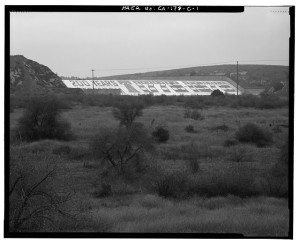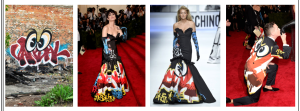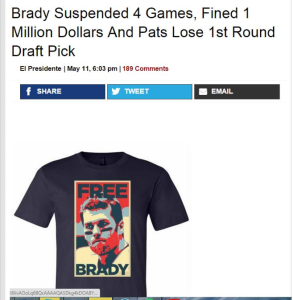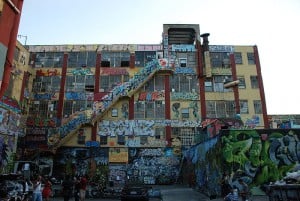A recent injunction ruling that prohibited the destruction of the “Bicentennial Freedom Mural” in Corona, California had occasion to consider the rights asserted by the plaintiffs and artists under the Visual Artists Rights Act of 1990 (VARA), 17 U.S.C. § 106A. The order ultimately granted the injunction but on different grounds, holding that the plaintiffs were unlikely to prevail on their VARA claim.
New VARA Ruling Muddies Analysis on Moral Rights and Significance of “Site Specific” Art
Topics: work of recognized stature, Mural Conservancy of Los Angeles, 555 U.S. 7, Moral Rights, United States Army Corps of Engineers, Cal. Civ. Code §§ 987 and 989, Inc., Visual Artists Rights Act of 1990, California, Santa Ana River Mainstem Project, Pippa Loengard, 54 U.S.C. § 306108, VARA, Kernochan Center for Law Media and the Arts, Corona, Ronald Kammeyer, Columbia Law School, Phillips v. Pembroke Real Estate, Copyright, Prado Dam, NHPA, Administrative Procedure Act, National Historic Preservation Act, 17 U.S.C. § 106A(a)(3)(A)-(B), 459 F.3d 128, 5 U.S.C. §§ 701-706, Winter v. Natural Res. Def. Council, SARM
Graffiti on the Runway: Street Artist Rime Pursues Lawsuit Against Moschino for Damaging His Street Cred
The fusion of street art, high fashion, and the law is hardly new, but the Italian designer Moschino’s latest foray into this genre has landed the company in court. Joseph Tierney, a well known graffiti artist who works under the pseudonym “Rime”, filed a complaint against Moschino and its creative director, Jeremy Scott, alleging copyright infringement, trademark violations under the Lanham Act, and unfair competition, and appropriation of name and likeness under California law. Moschino’s allegedly unauthorized use of his work has harmed the artist in numerous ways, Tierney alleges, not the least by opening him up to accusations of selling out. In the words of Tierney’s complaint: “nothing is more antithetical to the outsider ‘street cred’ that is essential to graffiti artists than association with European chic, luxury and glamour – of which Moschino is the epitome.” This theory of harm was something we talked about at the "Copyrights on the Street" panel at the Copyright Society of the USA meeting in Newport this year, and it is now being put to the test.
Topics: Joseph Tierney, copyright management information, Vandal Eyes, Digital Millennium Copyright Act, Rime, The Wall Street Journal, Graffiti Art, 17 U.S.C. § 1202, Gigi Hadid, Hollywood Reporter, Jeremy Scott, Copyright, Moschino, Lanham Act, The New York Times
Google Books, Fair Use, and Visual Art—Second Circuit Writes Decision That Would Have Helped Two Years Ago
With much anticipation, the Second Circuit issued its opinion last week in the Google Books case (Authors Guild et al. v. Google, Inc.), brought by authors Jim Bouton (of Ball Four fame) and others against Google for the latter’s program of scanning millions of library books, whether or not those books are in the public domain. My overwhelming reaction to the opinion, however, in the realm of visual art, is what a lost opportunity the Prince v. Cariou decision was two years ago, and some optimism that the most recent decision will start to provide useful guidance for practitioners that has been harder to give with confidence since Prince. After two years of the preeminence of the first fair use factor threatening to dwarf everything with a “transformativeness” test that essentially any use could meet, Google Books (even while finding a fair use) restores some balance to that analysis.
Topics: Richard Prince, Campbell v. Acuff-Rose Music, Hildebrand Gurlitt, 510 U.S. 569, Teenage Mutant Ninja Turtle, Prince v. Cariou, Second Circuit, Canal Zone, Patrick Cariou, Toward a Fair Use Standard, Michelangelo, Suicide Girls, Inc., Google Books, The Legal Guide for Museum Professionals, Pierre Laval, Jim Bouton, Copyright, transformativeness, Fair Use, Nazi-Looted Art: Risks and Best Practices for Muse
Art and the Digital Age, Wednesday 10/14 at the Boston Bar Association
Fresh off yesterday's panel at the IBA annual meeting in Vienna, I will be presenting a brown bag lunch lecture next week at the Boston Bar Association. Entitled "Art and the Digital Age," I'll explore what issues do digitization and a growing culture of appropriation create for the visual arts. In an era of social media and memes, a number of pitfalls and creative possibilities may not occur to the unwary. This talk will focus on what is and is not changing under the law, and what to look for in the future.
Topics: Boston Bar Association, Events, Copyright, Art and the Digital Age
Irony is Dead: PETA Sues for Copyright Infringement on Behalf of the Animal in the “Monkey Selfie”
In a year that began with the vagaries of Left Shark, we have our most bizarre art law story of 2015—so far. Last year, the United States Copyright Office released a public draft of the Third Edition of the Compendium of U.S. Copyright Office Practices. Among the new items that leapt out at practitioners was the section of examples of non-copyrightable works, which included “A photograph taken by a monkey.” The Copyright Office was inspired to include this example because of a 2011 photograph taken by British nature photographer David Slater. A crested black macaque picked up Slater’s camera and pressed the shutter button, and the result became known as the “monkey selfie.” While as I said at the time, I thought the point was debatable to the extent that Slater could intentionally have left the camera within reach of the animal the same way that leaving something exposed to nature could still result in a copyrightable work, the question was obviously (I thought) limited to whether or not Slater could restrict reproduction of the work as the author.
Topics: Left Shark, People for the Ethical Treatment of Animals, Blurb, Compendium of U.S. Copyright Office Practices, Wildlife Personalities., PETA, David Slater, Copyright, United States Copyright Office, Litigation
Anish Kapoor Sculpture Dispute Tests the Legal Utility of Terms Like Plagiarism and Appropriation
A sculpture in China that is remarkably similar to Anish Kapoor’s famous Cloud Gate in Chicago is highlighting how the colloquial use of words like appropriation and plagiarism, while useful and descriptive to distinguishing the creative process, can often confuse the issue when it comes to sorting out the parties’ legal rights. While the opinion here is that Kapoor has a good case for infringement (Cloud Gate-gate?), it is not the idea of plagiarism that would support his claim.
Topics: Donn Zaretsky, Xinjiang, Infringement, Pressure, SuicideGirls, Foreign Sovereign Immunities Act, Freddie Mercury, Rahm Emmanuel, Ma Jun, Chicago Sun Times, Ice Ice Baby, David Bowie, FSIA, Karamay, Copyright, Cloud Gate, Millennium Park, The Art Law Blog, Anish Kapoor, Plagiarism, Fair Use
"Free Brady" T Shirt Battle and Copyright: Who was First?
Somewhat tongue in cheek, we looked on Wednesday at the potential copyright implications from a back and forth between Governor Charlie Baker and Barstool Sports, which sells “Free Brady” T shirts (playing on Shepard Fairey’ famous Hope image) challenging the New England Patriots’ quarterback’s suspension by the National Football League (“DeflateGate” or “Ballghazi,” depending on who you ask). Gov. Baker recently wore a competing vendor’s “Free Brady” T shirt when doing the Ice Bucket Challenge. Given the sales potential arising out of one of the biggest stories in the country right now (insert decline-of-society comment here), however, the financial stakes are no laughing matter. The response to Wednesday's post has been overwhelming; we had more visitors in a three-hour window than we typically get in a month.
Topics: National Football League, Copyright Act, David Portnoy, Free Brady, Barstool Sports, DeflateGate, I Love Boston Sports, Ice Bucket Challenge, Shepard Fairey, Copyright, Senator Obama, NFL, Hope, Tom Brady, Ballghazi, Charlie Baker
Free Brady!—Did Governor Baker’s T-Shirt Have a Copyright Problem?
Tom Brady will be in New York today at a hearing in the litigation over his 4-game suspension by Roger Goodell for allegedly being “generally aware” of the deflation of footballs in the AFC Championship thrashing of the Indianapolis Colts last winter. For good legal analysis of the absolute fiasco that is the NFL’s attempt at a middle-school science project (instigated by the condition of a football introduced from the opposing team—but congratulations on another AFC Finalist banner) and the resulting adjudicatory process, I suggest John Dowd’s blog (“The NFL's investigation of and rules against Tom Brady are a travesty, and they've resulted in uncalled-for penalties. And it's all based on a report that lacks basic integrity, fairness and credibility.”). Dowd is an experienced federal prosecutor and led the investigation, among others, into Pete Rose and gambling for Major League Baseball. Most notably, he was sufficiently offended by the whole exercise to take the issue up with no relationship to the parties. Mike Florio at ProFootballTalk and Steph Stradley have also covered the story well.
Topics: Left Shark, ProFootballTalk, ALS. Metro, Copyright Act, Pete Frates, David Portnoy, Indianapolis Colts, AFC Championship, Free Brady, Mike Florio, Barstool Sports, Jacqueline Kennedy, John Dowd, Ice Bucket Challenge, Shepard Fairey, Major League Baseball, Copyright, Roger Goodell, Senator Obama, Hope, AFC Finalist, Andy Warhol, Tom Brady, Charlie Baker, Massachusetts Governor, Fair Use
Shepard Fairey Wanted on Vandalism Charge for Street Art in Detroit—Will This be the VARA Test Case?
Detroit police have issued a warrant for well-known artist Shepard Fairey in connection with his recent visit to the city, on suspicion of vandalism. While Fairey was apparently in Detroit to paint a commissioned mural at One Campus Martius, he told the Detroit Free Press, “I still do stuff on the street without permission. I'll be doing stuff on the street when I'm in Detroit.” According to the Free Press:
Topics: Richard Prince, Jeff Koons, Patrick Cariou, Moral Rights, Andre the Giant, Graffiti Art, Visual Artists Rights Act of 1990, Barack Obama, One Campus Martius, Banksy Does New York, VARA, Banksy, Shepard Fairey, appropriation copyright, Copyright, 5Pointz, Hope, Detroit Free Press, Associated Press, Fair Use
5Pointz Property Owner Sued Again Over Whitewashing of Graffiti—Measure of Damages Bears Watching
Several street artists have sued the property owners of the building in Queens that became known as “5Pointz”—a “Mecca” of graffiti and street art. This is the second such lawsuit, after another group of artists failed to obtain a preliminary injunction in November, 2013, and the owners whitewashed nearly all of the painting on the buildings. The new lawsuit seeks damages related to the whitewashing itself, alleging that it was done hastily and secretly without giving the artists sufficient time either to remove or document their work. It relies on the Visual Artists Rights Act of 1990 (VARA), the lone moral rights provision of the Copyright Act.
Topics: HBO, Copyright Act, Ishmael, Moral Rights, Richard Miller, Cady Nolan, Rodney Rodriguez, FCEE, Christoph Büchel’s, Graffiti Art, Visual Artists Rights Act, Patch Whiskey, Kai Niederhausen Semor, Kenji Takabayashi, recognized stature, Banksy Does New York, Jimmy C, VARA, Jerry Wolkoff, Bienbenido Guerra, Luis Gomez, MassMoCA, Banksy, TOOFLY, 17 U.S.C. § 106A, Carlo Nieva, Copyright, 5Pointz, PANIC, James Cochran, Sotheby's, Maria Castillo








